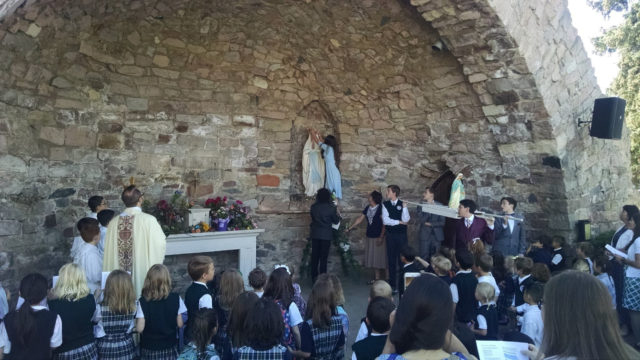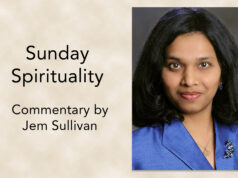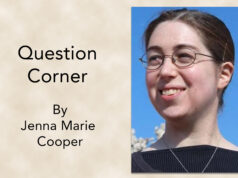
Any parent who ever grappled with the “new” math knows that education often falls victim to the latest trend.
But one growing trend in Catholic education is actually taking students back to what’s enduring and unchanging, according to Catherine Neumayr, who just completed seven years as principal of Holy Rosary Academy, an independent Catholic classical school in Anchorage, Alaska.
Classical Catholic education isn’t for everyone, and it hasn’t yet caught fire across the country. But, according to Neumayr, “there’s a resurgence in interest. Almost every major U.S. city has at least one Catholic school offering a classical education.”
Classical education begins with the premise that there is objective truth and that faith, reason and a rigorous education lead there.
There’s a heavy emphasis on classical Greek and Roman sources along with the works of ancient Fathers of the Church and theologians such as St. Thomas Aquinas. Students read primarily original sources rather than a synopsis of writings.
Proponents of classical education assert that theirs is a search for “truth, goodness and beauty.”
At Holy Rosary, students are introduced to Greek and take several years of Latin, all in an effort to establish what Neumayr calls “good habits of the mind and pure mental calisthenics.”
In a K-12 environment, a classical education is divided into three stages called a “trivium”: grammar, logic and rhetoric. Younger students learn facts and definitions and do much memorization, from prayers to the Gettysburg Address.
Beginning early, said Neumayr, there is “a de-emphasis on textbooks and an emphasis on primary sources.”
Junior high ushers in the logic stage, in which students learn to argue all sides of an issue, including opposing their own views. There’s an emphasis on parts of speech and language.
High school brings the rhetorical stage, with an emphasis on elegant writing, debate and oral presentations. Students read Shakespeare and engage in drama.
While some Catholic schools broaden their curriculum to accommodate a growing number of non-Catholic students, offering religion classes with titles like “World Religions,” a classical school adheres to a very basic education in Catholic faith and doctrine.
In the case of Holy Rosary Academy, parents of non-Catholic students are made aware that their children will be expected to attend Mass and participate in Catholic education classes. But no one is encouraged to convert. On the contrary, a true classical education encourages students to think for themselves.
The popularity of classical education began among evangelical Christians and the Catholic homeschool community. But it’s been embraced increasingly by Catholic parents seeking an alternative to public education or to Catholic schools criticized as being weak on “Catholic identity” or rigorous academics.
Neumayr’s love for classical education runs in the family. Her father, John Neumayr, a philosophy professor, was a founder in 1971 of Thomas Aquinas College in Santa Paula, California, a leader in offering a liberal arts curriculum that promises to “strive for fidelity to the magisterium” of the church through original sources and a strong Catholic education.
While there is enthusiasm among many for classical education, others see drawbacks.
Some may chafe at all that memorization. Do we need to memorize the Gettysburg Address, for instance, to have a deep appreciation for its beauty and significance?
A similar argument might be made about reading everything in its original source. Certainly a history student should read the U.S. Constitution and its amendments. But is reading the Magna Carta in its original language really better than a textbook synopsis? Shakespeare? Yes, but how about all of Chaucer’s “Canterbury Tales”? The argument might be made that some things are better left surveyed, if only for lack of time.
A classical education leaves little room for special education, and because of its emphasis on intense reading it can be tough for anyone with dyslexia. It also leaves less time for what many kids see as a pillar of high school — sports.
Small class size offers room for individual attention but sometimes makes socialization difficult.
“Some kids never find a friend,” Neumayr admits.
Another aspect of a classical education that may deter some Catholic parents is that the educational philosophy sometimes attracts a niche community.
A message of the Second Vatican Council was that the church should engage with the modern world, or as Pope Francis has phrased it, act as a “field hospital” to society’s pain. As such, many Catholic parents may hope that their children are exposed to the writings of the 20th century’s liberation theologians as well as St. Thomas Aquinas. Will classical education provide that?
And although Catholic parents want their children well-schooled in their faith, a look at world religions might offer a welcome bromide to the divides we face.
On the other hand, parents have seen schools — public and private — increasingly teaching far from their original mandate: think sex education, balancing your checkbook or an overemphasis on popular current events. Many parents want schools to get back to the basics and feel classical education makes that promise.
One way or the other, the growing popularity of classical education presents an opportunity to look critically at Catholic education as it’s offered in the U.S. today.
(Caldarola is a freelance writer and a columnist for Catholic News Service.)






